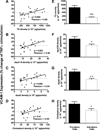IRF-1 and miRNA126 modulate VCAM-1 expression in response to a high-fat meal
- PMID: 22874466
- PMCID: PMC3810165
- DOI: 10.1161/CIRCRESAHA.112.270314
IRF-1 and miRNA126 modulate VCAM-1 expression in response to a high-fat meal
Abstract
Rationale: A high-fat diet accompanied by hypertriglyceridemia increases an individual's risk for development of atherosclerosis. An early event in this process is monocyte recruitment through binding to vascular cell adhesion molecule 1 (VCAM-1) upregulated on inflamed arterial endothelium. Diets high in polyunsaturated fatty acids (PUFAs) may provide athero-protection by ameliorating this effect.
Objective: We investigated the acute regulation of VCAM-1 expression in human aortic endothelial cells (HAEC) in response to triglyceride-rich lipoproteins (TGRL) isolated from subjects after consumption of a high-fat meal.
Methods and results: Postprandial TGRL isolated from 38 subjects were categorized as proatherogenic or antiatherogenic according to their capacity to alter the inflammatory response of HAEC. Proatherogenic TGRL increased expression of VCAM-1, intercellular adhesion molecule 1 (ICAM-1), and E-selectin by ≈20% compared with stimulation with tumor necrosis factor-α alone, whereas antiatherogenic TGRL decreased VCAM-1 expression by ≈20% while still upregulating ICAM-1. The relative atherogenicity of TGRL positively correlated with particle density of TG, apolipoprotein (Apo)CIII, ApoE, and cholesterol. Ω3-PUFA mimicked the effect of antiatherogenic TGRL by downregulating VCAM-1 expression. TGRL exerted this differential regulation of VCAM-1 by reciprocally modulating expression and activity of the transcription factor interferon regulatory factor 1 (IRF-1) and expression of microRNA 126 (miR-126). Overexpression or silencing of IRF-1 or miR-126 expression recapitulated the proatherogenic or antiatherogenic regulation of VCAM-1.
Conclusions: In response to a high-fat meal, TGRL bias the inflammatory response of endothelium via transcriptional and posttranscriptional editing of VCAM-1. Subjects with an anti-inflammatory response to a meal produced TGRL that was enriched in nonesterified fatty acids, decreased IRF-1 expression, increased miR-126 activity, and diminished monocyte arrest.
Figures







Similar articles
-
Oxylipins in triglyceride-rich lipoproteins of dyslipidemic subjects promote endothelial inflammation following a high fat meal.Sci Rep. 2019 Jun 17;9(1):8655. doi: 10.1038/s41598-019-45005-5. Sci Rep. 2019. PMID: 31209255 Free PMC article.
-
Triglyceride-rich lipoprotein modulates endothelial vascular cell adhesion molecule (VCAM)-1 expression via differential regulation of endoplasmic reticulum stress.PLoS One. 2013 Oct 21;8(10):e78322. doi: 10.1371/journal.pone.0078322. eCollection 2013. PLoS One. 2013. PMID: 24205197 Free PMC article.
-
Shear stress modulates VCAM-1 expression in response to TNF-α and dietary lipids via interferon regulatory factor-1 in cultured endothelium.Am J Physiol Heart Circ Physiol. 2013 Oct 15;305(8):H1149-57. doi: 10.1152/ajpheart.00311.2013. Epub 2013 Aug 9. Am J Physiol Heart Circ Physiol. 2013. PMID: 23934855 Free PMC article.
-
Postprandial lipoproteins and the molecular regulation of vascular homeostasis.Prog Lipid Res. 2013 Oct;52(4):446-64. doi: 10.1016/j.plipres.2013.06.001. Epub 2013 Jun 15. Prog Lipid Res. 2013. PMID: 23774609 Review.
-
High-energy diets, fatty acids and endothelial cell function: implications for atherosclerosis.J Am Coll Nutr. 2001 Apr;20(2 Suppl):97-105. doi: 10.1080/07315724.2001.10719021. J Am Coll Nutr. 2001. PMID: 11349944 Review.
Cited by
-
Oxylipins in triglyceride-rich lipoproteins of dyslipidemic subjects promote endothelial inflammation following a high fat meal.Sci Rep. 2019 Jun 17;9(1):8655. doi: 10.1038/s41598-019-45005-5. Sci Rep. 2019. PMID: 31209255 Free PMC article.
-
Triglyceride-rich lipoprotein modulates endothelial vascular cell adhesion molecule (VCAM)-1 expression via differential regulation of endoplasmic reticulum stress.PLoS One. 2013 Oct 21;8(10):e78322. doi: 10.1371/journal.pone.0078322. eCollection 2013. PLoS One. 2013. PMID: 24205197 Free PMC article.
-
MicroRNA expression in circulating microvesicles predicts cardiovascular events in patients with coronary artery disease.J Am Heart Assoc. 2014 Oct 27;3(6):e001249. doi: 10.1161/JAHA.114.001249. J Am Heart Assoc. 2014. PMID: 25349183 Free PMC article.
-
MiR-126-Loaded Immunoliposomes against Vascular Endothelial Inflammation In Vitro and Vivo Evaluation.Pharmaceutics. 2023 Apr 30;15(5):1379. doi: 10.3390/pharmaceutics15051379. Pharmaceutics. 2023. PMID: 37242620 Free PMC article.
-
MEK1/2 inhibitor inhibits neointima formation by activating miR-126-3p/ C-X-C motif chemokine ligand 12 (CXCL12)/C-X-C motif chemokine receptor 4 (CXCR4) axis.Bioengineered. 2022 Apr;13(4):11214-11227. doi: 10.1080/21655979.2022.2063496. Bioengineered. 2022. PMID: 35485167 Free PMC article.
References
-
- Karpe F. Postprandial lipoprotein metabolism and atherosclerosis. J Intern Med. 1999;246:341–355. - PubMed
-
- Miller M, Stone NJ, Ballantyne C, Bittner V, Criqui MH, Ginsberg HN, Goldberg AC, Howard WJ, Jacobson MS, Kris-Etherton PM, Lennie TA, Levi M, Mazzone T, Pennathur S. Triglycerides and cardiovascular disease: A scientific statement from the american heart association. Circulation. 2011;123:2292–2333. - PubMed
-
- Vogel RA, Corretti MC, Plotnick GD. Effect of a single high-fat meal on endothelial function in healthy subjects. Am J Cardiol. 1997;79:350–354. - PubMed
-
- Despres JP, Lemieux I, Bergeron J, Pibarot P, Mathieu P, Larose E, Rodes-Cabau J, Bertrand OF, Poirier P. Abdominal obesity and the metabolic syndrome: Contribution to global cardiometabolic risk. Arterioscler Thromb Vasc Biol. 2008;28:1039–1049. - PubMed
-
- Chan JW, Motton D, Rutledge JC, Keim NL, Huser T. Raman spectroscopic analysis of biochemical changes in individual triglyceride-rich lipoproteins in the pre- and postprandial state. Analytical chemistry. 2005;77:5870–5876. - PubMed
Publication types
MeSH terms
Substances
Grants and funding
LinkOut - more resources
Full Text Sources
Medical
Miscellaneous

